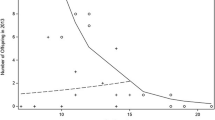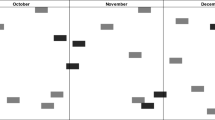Abstract
Demographic changes were recorded throughout a 12-year period for three social groups ofMacaca fascicularis in a natural population at Ketambe (Sumatra, Indonesia). We examined the prediction that females' lifetime reproductive success depended on dominance rank and group size. Average birth rate was 0.53 (184 infants born during 349 female years). For mature females (aged 8–20 yr) birth rate reflected physical condition, being higher in years with high food availability and lower in the year following the production of a surviving infant. High-ranking females were significantly more likely than low-ranking ones to give birth again when they did have a surviving offspring born the year before (0.50 vs 0.26), especially in years with relatively low food availability (0.37 vs 0.10). Controlled comparisons of groups at different sizes indicate a decline in birth rate with rroup size only once a group has exceeded a certain size. The dominance effect on birth rate tended to be strongest in large groups.
Survival of infants was rank-dependent, but the survival of juveniles was not. There was a trend for offspring survival to be lower in large groups than in mid-sized or small groups. However, rank and group size interacted, in that rank effects on offspring survival were strongest in large groups. High-ranking females were less likely to die themselves during their top-reproductive years, and thus on average had longer reproductive careers.
We estimated female lifetime reproductive success based on calculated age-specific birth rates and survival rates. The effects of rank and group size (contest and scramble) on birth rate, offspring survival, age of first reproduction for daughters, and length of reproductive career, while not each consistently statistically significant, added up to substantial effects on estimated lifetime reproductive success. The group size effects explain why large groups tend to split permanently.
Since females are philopatric in this species, and daughters achieve dominance rank positions similar to their mother, a close correlation is suggested between the lifetime reproductive success of mothers and daughters. For sons, too, maternal dominance affected their reproductive success: high-born males were more likely to become top-dominant (in another group). These data support the idea that natural selection has favored the evolution of a nepotistic rank system in this species, even if the annual benefits of dominance are small.
Similar content being viewed by others
References
Alberts, S.;Altmann, J. 1995. Balancing costs and opportunities: dispersal in male baboons.Amer. Naturalist, 145: 279–306.
Altmann, J.;Alberts, S. C.;Haines, S. A.;Dubach, J.;Muruthi, P.;Coote, T.;Geffen, E.;Cheesman, D. J.;Mututua, R. S.;Saiyalel, S. N.;Wayne, R. K.;Lacy, R. C.;Bruford, M. W. 1996. Behavior predicts genetic structure in a wild primate group.Proc. Natl. Acad. Sci. USA 93: 5797–5801.
Altmann, J.;Hausfater, G.;Altmann, S. A. 1988. Determinants of reproductive success in savannah baboons,Papio cynocephalus. In:Reproductive Success, Clutton-Brock, T. H. (ed.), The Univ. of Chicago Press, Chicago, pp. 403–418.
Altmann, J.;Muruthi, P. 1988. Differences in daily life between semiprovisioned a wild-feeding baboons.Amer. J. Primatol. 15: 213–221.
Barton, R. A.;Whiten, A. 1993. Feeding competition among female olive baboons,Papio anubis.Anim. Behav., 46: 777–789.
Bercovitch, F. B.;Berard, J. D. 1993. Life history costs and consequences of rapid reproductive maturation in female rhesus macaques.Behav. Ecol. Sociobiol., 32: 103–109.
Borries, C. 1993. Ecology of female social relationships: hanuman langurs (Presbytis entellus) and thevan Schaik model.Folia Primatol., 61: 21–30.
Borries, C.;Sommer, V.;Srivastava, A. 1991. Dominance, age, and reproductive success in free-ranging female hanuman langurs.Int. J. Primatol., 12: 230–257.
Brennan J.;Anderson, J. R. 1988. Varying responses to feeding competition in a group of rhesus monkeys (Macaca mulatta).Primates, 29: 353–360.
Bulger, J.;Hamilton III, W. J. 1987. Rank and density correlates of inclusive fitness measures in a natural chacma baboon (Papio ursinus) troop.Int. J. Primatol., 8: 635–650.
Busse, C. D. 1984. Spatial structure of chacma baboon groups.Int. J. Primatol., 5: 247–261.
Cheney, D. L.;Seyfarth, R. M.;Andelman, S. J.;Lee, P. C. 1988. Reproductive success in vervet monkeys. In:Reproductive Success, Clutton-Broock, T. H. (ed.) The Univ. of Chicago Press, Chicago, pp. 384–402.
Clutton-Brock, T. H. (ed.). 1988. Reproductive success. In:Reproductive Success, The Univ. of Chicago Press, Chicago, pp. 472–485.
Collins, D. A. 1984. Spatial pattern in a troop of yellow baboons (Papio cynocephalus) in Tazania.Anim. Behav. 32: 536–553.
Deutsch, J. C.;Lee, P. C. 1991. Dominance and feeding competition in captive rhesus monkeys.Int. J. Primatol., 12: 615–628.
Dittus, W. P. J. 1977. The social regulation of population density and age-sex distribution in the toque monkey,Behaviour, 63: 281–322.
Dittus, W. P. J. 1988. Group fission among wild toque macaques as a consequence of female resource competition and environmental stress.Anim. Behav., 36: 1626–1645.
Fedigan, L. M.;Fedigan, L.;Gouzoules, S.;Gouzoules, H.;Koyama, N. 1986. Lifetime reproductive success in female Japanese macaques.Folia Primatol., 47: 143–157.
Griffiths, M.;van Schaik, C. P. 1993. The impact of human traffic on the abundance and activity periods of Sumatran rain forest wildlife.Conserv. Biol., 7: 623–626.
Hall, C. L.;Fedigan, L. M. 1997. Spatial benefits afforded by high rank in white-faced capuchins.Anim. Behav., 53: 1069–1082.
Hausfater, G.;Altmann, J.;Altmann, S. 1982. Long-term consistency of dominance relations among female baboons.Science, 217: 752–755.
Henzi, S. P.;Lycett, J. E.;Piper, S. E. 1997. Fission and troop size in a mountain baboon populationAnim. Behav. 53: 525–535.
Hill, D. A.;Okayasu, N. 1996. Determinants of dominance among female macaques: nepotism, demography and danger. In:Evolution and Ecology of Macaque Societies,Fa J. E.;Lindburg,D. G. (eds.), Cambridge Univ. Press, Cambridge, pp. 459–472.
Itoigawa, N.;Tanaka, T.;Ukai, N.;Fujii, H.;Kurokawa, T.;Koyama, T.;Ando, A.;Watanabe, Y.;Imakawa, S. 1992. Demography and reproductive parameters of a free-ranging group of Japanese macaques (Macaca fuscata) at Katsuyama.Primates, 33: 49–68.
Janson, C. H. 1990a. Social correlates of individual spatial choice in foraging groups of brown capuchin monkeys,Cebus apella.Anim. Behav., 40: 910–921.
Janson, C. H. 1990b. Ecological consequences of individual spatial choice in foraging groups of brown capuchin monkeys,Cebus apella.Anim. Behav., 40: 922–934.
Kavanagh, M.;Laursen, R. 1984. Breeding seasonality among long-tailed macaques,Macaca fascicularis, in Peninsular Malaysia.Int. J. Primatol. 5: 17–29.
Kawai, M. 1965. On the system of social ranks in a natural troop of Japanese monkeys. I: Basic rank and dependent rank. In:Japanese Monkeys,Imanishi,K.;Altmann,S. A. (eds), Emory Univ. Press, Atlanta, pp. 66–86.
Koyama, N.;Takahata, Y.;Huffman, M. A.;Norikoshi, K.;Suzuki, H. 1992. Reproductive parameters of female Japanese macaques: thirty years data from the Arashiyama Troops, Japan.Primates, 33: 33–47.
Kuester, J.;Paul, A.;Arnemann, J. 1995. Age-related and individual differences of reproductive success in male and female barbary macaques (Macaca sylvanus).Primates, 36: 461–476.
Ménard, N.;Vallet, D. 1996. Demography and ecology of barbary macaques (Macaca sylvanus) in two different habitats. In:Evolution and Ecology of Macaque Societies,Fa,J. E.;Lindburg,D. G. (eds.), Cambridge Univ. Press, Cambridge, pp. 106–131.
Mori, A. 1979. Analysis of population changes by measurement of body weight in the Koshima troop of Japanese monkeys.Primates, 20: 371–397.
Mori, A.;Watanabe, K.;Yamaguchi, N. 1989. Longitudinal changes of dominance rank among the females of the Koshima group of Japanese monkeys.Primates, 30: 147–173.
Mori, A.;Yamaguchi, N.;Watanabe, K.;Shimizu, K. 1997. Sexual maturation of female Japanese macaques under poor nutritional conditions and food-enhanced perineal swelling in the Koshima troop.Int. J. Primatol., 18: 553–579.
van Noordwijk, M. A. 1985. Sexual behaviour of Sumatran long-tailed macaques (Macaca fascicularis).Z. Tiepsychol. 70: 277–296.
van Noordwijk, M. A.;van Schaik, C. P. 1985. Male migration and rank acquisition in wild long-tailed macaques (Macaca fascicularis).Anim. Behav. 33: 849–861.
van Noordwijk, M. A.;van Schaik, C. P. 1987. Competition among female long-tailed macaques,Macaca fascicularis.Anim. Behav., 35: 577–589.
van Noordwijk, M. A.;van Schaik, C. P. 1988. Male careers in Sumatran long-tailed macaques (Macaca fascicularis).Behaviour, 107: 24–43.
Oi, T. 1996. Sexual behaviour and mating system of the wild pig-tailed macaque in West Sumatra. In:Evolution and Ecology of Macaque Societies,Fa,J. E.;Lindburg,D. G. (eds), Cambridge Univ. Press, Cambridge, pp. 342–368.
Packer, C.;Collins, D. A.;Sindimwo, A.;Goodall, J. 1995. Reproductive constraints on aggressive competition in female baboons.Nature, 373: 60–63.
Paul, A.;Kuester, J. 1990. Adaptive significance of sex ratio adjustment in semifree-ranging barbary macaques (Macaca sylvanus) at Salem.Behav. Ecol. Sociobiol., 30: 337–341.
Paul, A.;Kuester, J. 1996. Differential reproduction in male and female barbary macaques. In:Evolution and Ecology of Macaque Societies,Fa,J. E.;Lindburg,D. G. (eds.), Cambridge Univ. Press, Cambridge, pp. 293–317.
Paul, A.;Kuester, J.;Arnemann, J. 1992. Maternal rank affects reproductive success of male barbary macaques (Macaca sylvanus): evidence from DNA fingerprinting.Behav. Ecol. Sociobiol., 30: 337–341.
Pusey, A.;Williams, J.;Goodall, J. 1997. The influence of dominance rank on the reproductive success of female chimpanzees.Science, 277: 828–831.
Robinson, J. G. 1981. Spatial structure in foraging groups of wedge-capped capuchin monkeysCebus nigrivittatus.Anim. Behav., 29: 1036–1056.
Robinson, J. G. 1988. Group size in wedge-capped capuchin monkeys,Cebus olivaceus, and the reproductive success of males and females.Behav. Ecol. Sociobiol. 23: 187–197.
Ron, T. 1996. Who is responsible for fission in a free-ranging troop of baboons?Ethology, 102: 128–133.
Ron, T.;Henzi, S. P.;Motro, U. 1996. Do female chacma baboons compete for safe spatial positions in a southern woodland habital?Behaviour, 133: 475–490.
De Ruiter, J. R.;van Hooff, J. A. R. A. M.;Scheffrahn, W. 1994. Social and genetic aspects of paternity in wild long-tailed macaques (Macaca fascicularis).Behaviour, 129: 203–224.
van Schaik, C. P. 1983. Why are diurnal primates living in groups?Behaviour, 87: 120–144.
van Schaik, C. P.. 1986. Phenological changes in a Sumatran rain forest.J. Trop. Ecol., 2: 327–347.
van Schaik, C. P.;Mirmanto, E. 1985. Spatial variation in structure and litterfall of a Sumatran rain forest.Biotropica, 17: 196–205.
van Schaik, C. P.;Netto, W. J.;van Hooff, J. A. R. A. M. 1989. Java-apen (Macaca fascicularis): sociale organisatie in het tropisch regenwoud en groepsbeheer in het laboratorium.Biotechniek, 28: 6–8.
van Schaik, C. P.;van Noordwijk, M. A. 1985. Interannual variability in fruit abundance and reproductive seasonality in Sumatran long-tailed macaques (Macaca fascicularis).J. Zool. Lond., 206: 533–549.
van Schaik, C. P.;van, Noordwijk, M. A. 1988. Scramble and contest in feeding competition among female long-tailed macaques (Macaca fascicularis).Behaviour, 105: 77–98.
van Schaik, C. P.;van Noordwijk, M. A.;van Bragt, T.;Blankenstein, M. A. 1991. A pilot study of the social correlates of levels of urinary cortisol, prolactin, and testosterone in wild long-tailed macaques (Macaca fascicularis).Primates, 32: 345–356.
Silk, J. B. 1987.Social Behavior in Evolutionary Perspective. Chicago Univ. Press, Chicago.
Silk, J. B. 1993. The evolution of social conflict among female primates. In:Primate Social Conflict,Mason,W. A.;Mendoza,S. P. (eds.), State Univ. of New York, New York, pp. 49–83.
Sokal, R. R.;Rohlf, F. J. 1981.Biometry, W. H. Freeman, New York.
Sterck, E. H. M.;Steenbeek, R. 1997. Female dominance relationships and food competition in the sympatric Thomas langur and long-tailed macaque.Behaviour, 134: 749–774.
Sterck, E. H. M.;Watts, D. P.;van Schaik, C. P. 1997. The evolution of female social relationships in nonhuman primates.Behav. Ecol. Sociobiol., 41:291–309.
Sugiyama, Y.;Ohsawa, H. 1982. Population dynamics of Japanese monkeys with special reference to the effect of artificial feeding.Folia Primatol., 39: 238–263.
Suzuki, S.;Noma, N.;Izawa, K. 1988. Inter-annual variation of reproductive parameters and fruit availability in two populations of Japanese macaques.Primates, 39: 313–324.
de Waal, F. B. M. 1977. The organization of agonistic relations within two captive groups of Javamonkeys (Macaca fascicularis).Z. Tierpsychol., 44: 225–282.
de Waal, F. B. M. 1987. Dynamics of social relationships. In:Primate Societies,Smuts,B. B.;Cheney,D. L.;Seyfarth,R. M.;Wrangham,R. W.;Struhsaker,T. T. (eds.), Univ. of Chicago Press, Chicago, pp. 421–429.
Walters, J. R.;Seyfarth, R. M. 1987. Conflict and cooperation. In:Primate Societies,Smuts,B. B.;Cheney,D. L.;Seyfarth,R. M.;Wrangham,R. W.;Struhsaker,T. T. (eds.), Univ. of Chicago Press, Chicago, pp. 306–317.
Watanabe, K.;Mori, A.;Kawai, M. 1992. Characteristic features of the reproduction of Koshima monkeys,Macaca fuscata fuscata: a summary of thirty-four years of observation.Primates, 33: 1–32.
Whitten, P. L. 1983. Diet and dominance among female vervet monkeys (Cercopithecus aethiops).Amer. J. Primatol., 5: 139–159.
Wrangham, R. W. 1980. An ecological model of female-bonded primate groups.Behaviour, 75: 262–299.
Author information
Authors and Affiliations
About this article
Cite this article
van Noordwijk, M.A., van Schaik, C.P. The effects of dominance rank and group size on female lifetime reproductive success in wild long-tailed macaques,Macaca fascicularis . Primates 40, 105–130 (1999). https://doi.org/10.1007/BF02557705
Received:
Accepted:
Published:
Issue Date:
DOI: https://doi.org/10.1007/BF02557705




